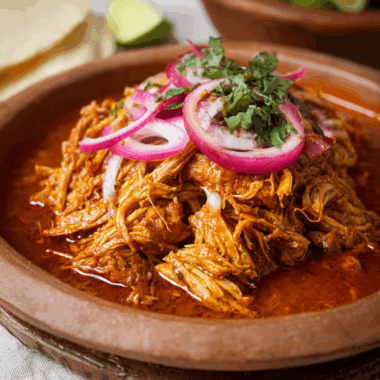Chiles en Nogada is more than just a dish—it’s a symbol of history and culture on a plate. Originating in Puebla, Mexico, this recipe celebrates independence with its vibrant colors representing the Mexican flag: green poblano peppers, creamy white walnut sauce, and ruby red pomegranate seeds.
This festive meal beautifully balances savory spiced meat with the sweetness of fresh fruit, while the rich walnut sauce ties everything together. Often prepared for special occasions, it is as eye-catching as it is flavorful, making it perfect for celebrations, holidays, or any meal where you want to bring both tradition and artistry to the table.
Full Recipe:
-
6 fresh poblano peppers
-
1 tablespoon vegetable oil
-
1 onion, finely chopped
-
2 cloves garlic, minced
-
1 pound ground beef (or pork, or a mix)
-
2 medium tomatoes, finely chopped
-
1 apple, peeled and diced
-
1 pear, peeled and diced
-
1 peach, peeled and diced
-
1/4 cup raisins
-
1/4 cup chopped almonds
-
1 teaspoon ground cinnamon
-
1/2 teaspoon ground cloves
-
1/2 teaspoon ground nutmeg
-
Salt and pepper, to taste
For the Walnut Sauce:
-
1 cup walnuts, soaked in hot water and peeled
-
1/2 cup milk (or cream for richness)
-
1/4 cup queso fresco or mild white cheese
-
2 tablespoons sugar
-
Pinch of cinnamon
For Garnish:
-
1/2 cup pomegranate seeds
-
Fresh parsley leaves
Directions:
-
Roast poblano peppers over an open flame or under a broiler until skin blisters. Place in a plastic bag for 10 minutes, then peel off skins carefully. Make a small slit to remove seeds while keeping peppers whole.
-
Heat oil in a skillet over medium heat. Add onion and garlic, sauté until fragrant.
-
Stir in ground meat and cook until browned. Add tomatoes, apple, pear, peach, raisins, almonds, and spices. Cook 10–15 minutes until fruit softens and mixture thickens. Season with salt and pepper.
-
Prepare walnut sauce by blending walnuts, milk, cheese, sugar, and cinnamon until smooth and creamy. Adjust consistency with more milk if needed.
-
Stuff each poblano pepper with the meat and fruit mixture, then place on a serving plate.
-
Generously spoon walnut sauce over peppers, then sprinkle with pomegranate seeds and parsley for garnish.
Prep Time: 30 minutes | Cooking Time: 45 minutes | Total Time: 1 hour 15 minutes
Kcal: ~420 kcal | Servings: 6 servings
The Story Behind Chiles en Nogada
Few dishes capture the heart and spirit of a nation the way Chiles en Nogada does in Mexico. This dish is far more than food—it is a celebration of culture, history, and identity. Originating from the state of Puebla in the early 19th century, the recipe was first prepared by Augustinian nuns to honor Agustín de Iturbide, one of the leaders of Mexico’s independence movement. The colors of the dish—green from the poblano peppers, white from the walnut sauce, and red from the pomegranate seeds—were chosen deliberately to reflect the Mexican flag. Over time, Chiles en Nogada became synonymous with national pride and is now enjoyed widely during patriotic festivities, particularly in September, the month of Mexican independence.
A Dish Rich in Symbolism
Every element of Chiles en Nogada tells a story. The vibrant green poblano pepper represents hope, fertility, and the fertile lands of Mexico. The creamy white walnut sauce is a nod to purity and unity, while the burst of ruby-red pomegranate seeds symbolizes the blood of national heroes and the struggles for independence. This symbolism elevates the dish from a mere culinary creation to a cultural emblem. Serving Chiles en Nogada at a table often evokes nostalgia and patriotic pride, reminding Mexicans of their heritage and the sacrifices of those who fought for freedom.
The Unique Flavor Profile
Unlike many savory dishes, Chiles en Nogada is renowned for its extraordinary balance of flavors. The filling typically combines ground meat with sweet, juicy fruits such as apples, pears, and peaches, along with nuts, raisins, and aromatic spices. This blend delivers a complexity that oscillates between savory, sweet, and subtly spiced. The walnut-based nogada sauce, creamy and slightly sweet, mellows the intensity of the peppers and filling. Finally, the pomegranate seeds add bursts of tart freshness, tying the dish together with a touch of elegance. This intricate harmony makes Chiles en Nogada one of the most sophisticated and beloved recipes in Mexican cuisine.
A Seasonal Specialty
One of the most fascinating aspects of Chiles en Nogada is its deep connection to the harvest season. Traditionally, the dish is prepared when the fruits and nuts used in the stuffing reach their peak ripeness, typically in late summer to early autumn. This is why Chiles en Nogada is so closely tied to Mexico’s independence celebrations in September. The seasonality ensures that the flavors are at their most vibrant and fresh, making it a dish that locals look forward to all year. In modern times, however, global trade and refrigeration make it possible to enjoy Chiles en Nogada beyond its traditional season, though purists argue that nothing compares to the freshness of the original timing.
Regional Pride from Puebla
Though widely enjoyed throughout Mexico and beyond, Chiles en Nogada remains a point of pride for Puebla, the city where it originated. Puebla is already famous for its culinary contributions—most notably mole poblano—and Chiles en Nogada stands proudly among them as a dish that reflects both the creativity and the cultural depth of the region. Many families in Puebla pass down their own unique versions of the recipe, each adding subtle touches that distinguish one household’s preparation from another. This variety ensures that the dish remains dynamic, evolving while still retaining its traditional core.
Cultural Celebrations and Traditions
The cultural significance of Chiles en Nogada is most evident during Mexico’s Independence Day celebrations in September. Families gather around tables adorned with this dish, and restaurants proudly feature it as a seasonal highlight. Beyond the holiday, it is also commonly served at weddings, anniversaries, and other major celebrations, where its beauty and symbolism make it the centerpiece of a festive meal. The dish embodies a sense of communal joy and shared identity, making it not only a gastronomic treasure but also a cultural ritual.
Presentation and Aesthetic Appeal
Chiles en Nogada is a feast for the eyes as much as it is for the palate. The striking contrast of colors—the green poblano, the smooth white walnut sauce cascading over the pepper, and the brilliant red pomegranate seeds sprinkled like jewels—creates an unforgettable presentation. This visual beauty is one of the reasons the dish is frequently photographed and shared in culinary circles worldwide. The garnishing of fresh parsley adds a final touch of freshness, reinforcing the harmony of flavors while enhancing the plate’s vibrant appearance.
Variations and Modern Adaptations
While tradition is at the heart of Chiles en Nogada, contemporary chefs and home cooks often adapt the dish to suit modern tastes and dietary preferences. Some variations use vegetarian fillings, replacing meat with lentils, mushrooms, or even quinoa, while still retaining the sweet-fruit combination that defines the dish. Others experiment with lighter sauces, such as cashew cream, to accommodate vegan diets. Though purists may prefer the original preparation, these adaptations highlight the dish’s versatility and its ability to remain relevant across different generations and lifestyles.
The Effort Behind the Dish
Chiles en Nogada is not a quick recipe. Preparing it requires patience, attention to detail, and a respect for tradition. From roasting and peeling the poblano peppers, to carefully crafting the filling, to blending the creamy nogada sauce, each step demands care. The assembly and final garnishing require an artistic touch. This is why many Mexicans consider Chiles en Nogada a labor of love—a dish that is not made casually but reserved for special occasions. The effort invested in preparing it makes the experience of eating it even more rewarding.
A Culinary Ambassador of Mexico
Beyond its presence in Mexican households, Chiles en Nogada has become a culinary ambassador of Mexican cuisine to the world. Featured in cookbooks, international festivals, and fine dining establishments, it serves as an example of the sophistication and depth of Mexican gastronomy. It challenges the notion that Mexican food is only about tacos, enchiladas, or street snacks, instead presenting a refined, elegant dish that rivals the great culinary traditions of Europe or Asia. This global recognition strengthens pride in Mexico’s culinary heritage and ensures that Chiles en Nogada remains celebrated far beyond its birthplace.
Conclusion
Chiles en Nogada is far more than a festive meal; it is a tapestry woven with history, culture, symbolism, and flavor. From its patriotic roots in Puebla to its status as a national treasure, the dish continues to unite Mexicans around a shared sense of pride and tradition. Its unique flavor profile, striking appearance, and rich symbolism make it one of the most distinctive dishes in the world. Whether enjoyed during September celebrations or prepared as a special family meal, Chiles en Nogada tells the story of Mexico on every plate. It is a reminder that food is not just nourishment but also memory, identity, and celebration—a true masterpiece of culinary heritage.








